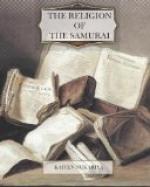[FN#350] A. ‘He understands the truth of misery.’ The truth of Duhkha, or misery, is the first of the four Noble Satyas, or Truths, that ought to be realized by the Hinayanists. According to the Hinayana doctrine, misery is a necessary concomitant of sentient life.’
[FN#351] A. ‘He destroys Samudaya.’ The truth of Samudaya, or accumulation, the second of the four Satyas, means that misery is accumulated or produced by passions. This truth should be realized by the removal of passions.
[FN#352] A. ‘This is the truth of Marga.’ The truth of Marga, or Path, is the fourth of the four Satyas. There are the eight right Paths that lead to the extinction of passions; (1) Right view (to discern truth), (2) right thought (or purity of will and thought), (3) right speech (free from nonsense and errors), (4) right action, (5) right diligence, (6) right meditation, (7) right memory, (8) right livelihood.
[FN#353] A. ‘This is the truth of Nirodha.’ Nirodha, or destruction, the third of the four Satyas, means the extinction of passions. Bhutatathati of Anatman means the truth of the non existence of Atma or soul, and is the aim and end of the Hinayanist philosophy.
[FN#354] Arhat, the Killer of thieves (i.e., passions), means one who conquered his passions. It means, secondly, one who is exempted from birth, or one who is free from transmigration. Thirdly, it means one deserving worship. So the Arhat is the highest sage who has attained to Nirvana by the destruction of all passions.
According to the doctrine of this school the two aggregates, material and spiritual, together with lust, anger, and folly, are the origin of ourselves and of the world in which we live. There exists nothing else, either in the past or in the future, that can be regarded as the origin.
Now let us say (a few words) by way of refutation. That which (always) stands as the origin of life, birth after birth, generation after generation, should exist by itself without cessation. Yet the Five Vijnyanas[FN#355] cease to perform their functions when they lack proper conditions, (while) the Mano-vijnyana[FN#356] is lost at times (in unconsciousness). There are none of those four (material) elements in the heavenly worlds of Arupa. How, then, is life sustained there and kept up in continuous birth after birth? Therefore we know that those who devote themselves to the study of this doctrine also cannot trace life to its origin.
[FN#355] A. ‘The conditions are the Indriyas and the Visayas, etc.’ Indriyas are organs of sense, and Visayas are objects on which the sense acts. Five Vijnyanas are—(1) The sense of sight, (2) the sense of hearing, (3) the sense of smell, (4) the sense of taste, (5) the sense of touch.
[FN#356] Mano-vijnyana is the mind itself, and the last of the six Vijnyanas of the Hinayana doctrine. A. ’(For instance), in a state of trance, in deep slumber, in Nirodha-samapatti (where no thought exists), in Asamjnyi-samapatti (in which no consciousness exists), and in Avrhaloka (the thirteenth of Brahmalokas).




